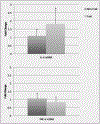Intramuscular fat and inflammation differ in older adults: the impact of frailty and inactivity
- PMID: 24886741
- PMCID: PMC6639009
- DOI: 10.1007/s12603-014-0019-1
Intramuscular fat and inflammation differ in older adults: the impact of frailty and inactivity
Abstract
Objectives: Intramuscular adipose tissue (IMAT) is recognized as a negative predictor of both muscle and mobility function in older adults, however the mechanism by which IMAT may negatively influence muscle and mobility function is currently unknown. The release of pro-inflammatory cytokines from IMAT provides a potential reason for these negative associations. To explore this hypothesis we compared IMAT and muscular inflammation in age-and BMI-matched older non-obese frail and non-frail adults. We also sought to examine the relationship between IMAT and inflammation, and muscle and mobility function in this group of older adults.
Design: A case-control sampling was used for this study. Age-and BMI-matched non-obese frail and non-frail individuals (<65 years) were recruited.
Measurements: MRI was used to quantify thigh IMAT and lean tissue. Unilateral muscle biopsies were used to quantify muscular inflammation as represented by interleukin-6 (IL-6) and tumor-necrosis factor alpha (TNF-α). Muscle and mobility function was also measured using a maximal voluntary isometric contraction, six-minute walk, and self-selected gait speed.
Participants: 26 older (80.7 +/- 5.4 years) individuals (8 frail and 18 non-frail) were enrolled.
Results: The frail-group had increased IMAT (p<0.01) and decreased lean tissue (p<0.01), and elevated IL-6 muscle mRNA (p=0.02) and IL-6 protein content (p=0.02) compared to the non-frail group. IMAT was significantly associated with IL-6 mRNA (r=0.43, p=.04) and protein expression within the muscle (r=0.41, p= 0.045). IL-6 mRNA was significantly associated with six-minute walk (r=-0.63, p<0.01), and gait speed (r=-0.60, p <0.01) and IL-6 protein was significantly associated with muscle force (r=-0.54, p=0.01), six-minute walk (r=-0.66, p<0.01), and gait speed (r=-0.76, p<0.01). No significant relationships were found for any variables with TNF-a.
Conclusion: Non-obese, older, frail individuals have increased IMAT and muscular inflammation when compared to their non-frail, age- and BMI-matched peers. A significant relationship exists between IMAT and muscle IL-6 expression as well as between IL-6 and muscle and mobility function of these older adults. This IMAT-inflammatory pathway provides a potential link between IMATs and decreased muscle and mobility function.
Figures



References
-
- Goodpaster BH, et al., Attenuation of skeletal muscle and strength in the elderly: The Health ABC Study. J Appl Physiol, 2001. 90(6): p. 2157–65. - PubMed
-
- Visser M, et al., Leg muscle mass and composition in relation to lower extremity performance in men and women aged 70 to 79: the health, aging and body composition study. J Am Geriatr Soc, 2002. 50(5): p. 897–904. - PubMed
-
- Goodpaster BH, et al., Association between regional adipose tissue distribution and both type 2 diabetes and impaired glucose tolerance in elderly men and women. Diabetes Care, 2003. 26(2): p. 372–9. - PubMed
-
- Manini TM, et al., Reduced physical activity increases intermuscular adipose tissue in healthy young adults. Am J Clin Nutr, 2007. 85(2): p. 377–84. - PubMed
Publication types
MeSH terms
Substances
Grants and funding
LinkOut - more resources
Full Text Sources
Other Literature Sources
Medical

